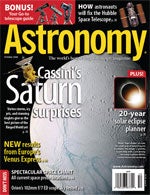
More resources from Astronomy.com:
- Astronomy news
- Astronomy basics
- Glossary of astronomical terms
- Return to Astronomy “For the media” page
Astronomy‘s mission:
Astronomy promotes the science and hobby of astronomy through high-quality publications that engage, inform, entertain, and inspire.
August 28, 2008
WAUKESHA, Wis. — NASA’s Cassini spacecraft has spent the past 4 years at Saturn. In its short lifetime, the spacecraft has discovered methane on Titan, icy plumes on Enceladus, and a vast amount of details in the planet’s rings and atmospheres.
In “Saturn revolution,” Linda Spilker, deputy project scientist for the Cassini mission, explains what Cassini teaches us about our solar system’s ringed planet and what astronomers will discover from all the new images and data.
“If Cassini’s first 4 years are any guide,” writes Spilker, “planetary scientists should expect the unexpected.”
Pick up the October issue of Astronomy to read all about Cassini and to see the stunning images the spacecraft has returned.
Take a sneak peek inside the October 2008 issue.
“Astronomy‘s guide to Go-to telescopes”
This month’s issue of Astronomy includes a bonus pullout “Guide to Go-to telescopes.” Contributing Editor Phil Harrington reviews 23 of the best to help find the telescope that fits your observing needs. In addition, the guide includes a special section on CCD cameras.
“Your 20-year solar eclipse planner”
Looking for an exciting family vacation? Travel to Chile in 2020 to catch a 2-minute eclipse. Or, how about Easter Island in 2010 to experience more than 4½ minutes of complete darkness?
Senior Editor Michael E. Bakich highlights the upcoming solar eclipses in “Your 20-year solar eclipse planner.” The Earth will host 15 total solar eclipses between now and 2028.
October night-sky events visible without optical aid
October 21 — Catch an Orionid meteor shower.
October 31 — Spot Antares next to the Moon when Venus joins them in the night sky.
Also in the October 2008 Astronomy
- “How we’ll fix Hubble” — NASA returns to the Hubble Space Telescope one last time.
- “Taking Venus by storm” — Europe’s new spacecraft returns observations of the composition, circulation patterns, and intense lightning of our sister world’s atmosphere.
- “Calling all space probes” — See an illustrated spread of the spacecraft that monitor the Sun, study Saturn, and explore interplanetary – and soon, interstellar — space.
- “The sky this month” — Exclusive pullout star charts will guide you through October’s night sky.
- The October issue of Astronomy also includes Astro news, Bob Berman’s strange universe, Glenn Chaple’s observing basics, Phil Harrington’s binocular universe, Stephen James O’Meara’s secret sky, New products, and Reader gallery.









